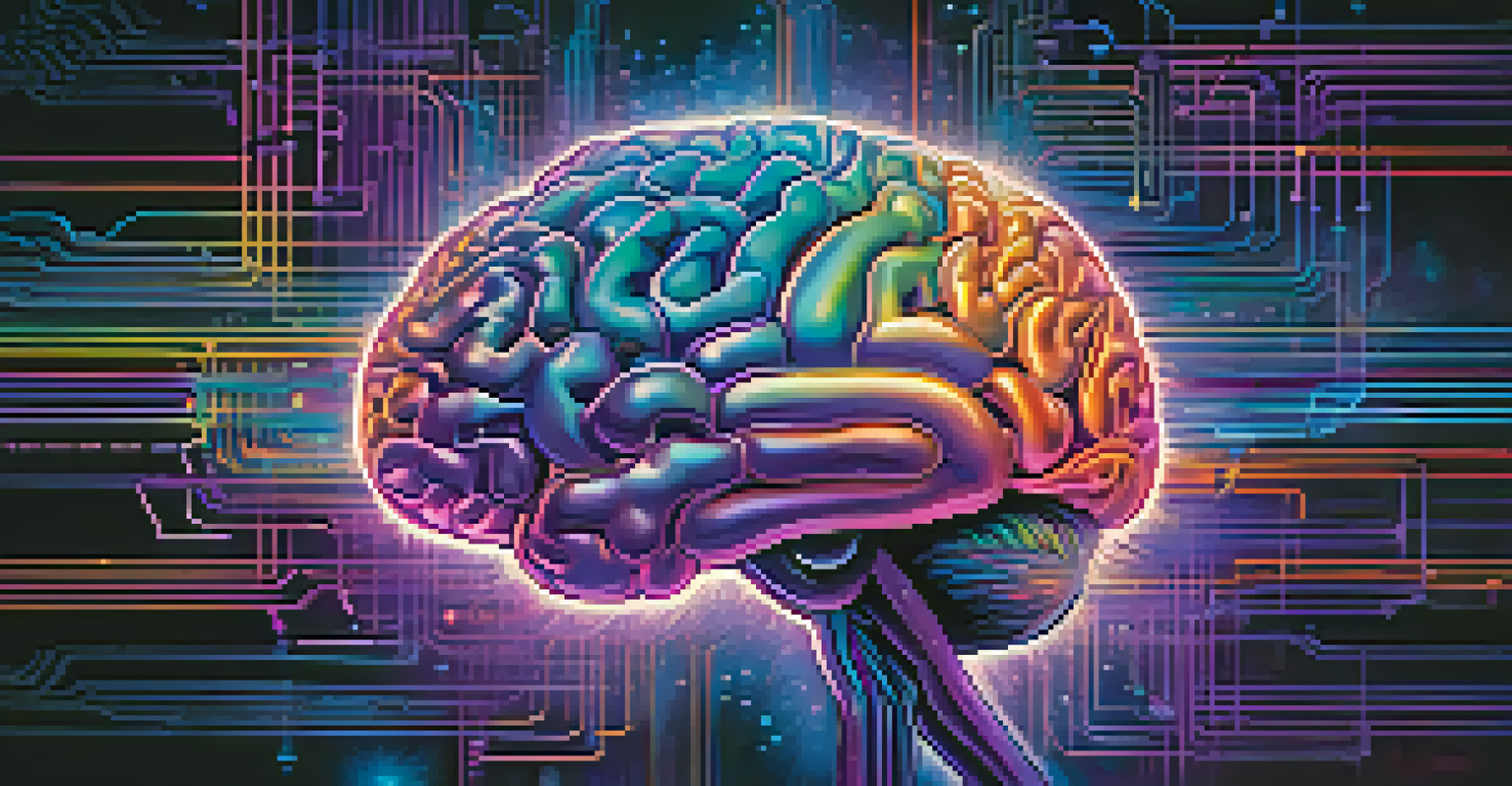Comparative Study of Psilocybin and LSD in Therapeutic Use

Understanding Psilocybin and LSD: The Basics
Psilocybin and LSD are both powerful psychedelics, but they originate from different sources. Psilocybin is a naturally occurring compound found in certain mushrooms, often referred to as magic mushrooms. In contrast, LSD, or lysergic acid diethylamide, is a synthetic substance derived from ergot, a fungus that grows on rye and other grains.
Psychedelics can offer a powerful lens to explore the depths of human consciousness and unlock the potential for healing.
Though they have different chemical structures, both substances interact with serotonin receptors in the brain, leading to altered perception, mood changes, and profound introspective experiences. This shared mechanism has sparked interest in their potential therapeutic applications, particularly in mental health treatment.
As research on psychedelics gains momentum, understanding the unique effects and potential benefits of psilocybin and LSD is crucial. Both have shown promise in treating conditions like depression, anxiety, and PTSD, but their differences may influence their therapeutic effectiveness.
Historical Context: Psychedelics in Therapy
The use of psychedelics in therapeutic settings dates back to the mid-20th century. Early studies explored their potential to treat various mental health issues, but these efforts were largely halted due to the counterculture movement and subsequent legal restrictions. Despite this setback, interest has resurfaced in recent years, leading to new studies and a reevaluation of their therapeutic potential.

Research has shown that both psilocybin and LSD can induce significant psychological shifts, allowing patients to confront and process traumatic experiences. For instance, in the 1960s, LSD was used in psychotherapy to help patients access repressed memories and emotions, leading to breakthroughs in treatment.
Psychedelics Show Mental Health Promise
Both psilocybin and LSD have demonstrated potential in treating mental health conditions like depression and anxiety through therapeutic applications.
Today, researchers are revisiting these substances with modern scientific methods, aiming to validate their benefits and understand their mechanisms of action. This renewed interest is paving the way for a more nuanced understanding of how these psychedelics can support mental health.
Mechanisms of Action: How They Work
Both psilocybin and LSD primarily affect serotonin receptors in the brain, particularly the 5-HT2A receptor. When these substances bind to this receptor, they trigger a cascade of neurochemical changes that can enhance mood and alter perception. This interaction is believed to play a key role in their therapeutic effects, including feelings of connectedness and emotional release.
The experience of using psychedelics is often a deep dive into one's own psyche, leading to insights that can be profoundly therapeutic.
However, the way each substance affects the brain can differ. Psilocybin tends to produce a more grounded, introspective experience, while LSD often leads to more vivid visual effects and a heightened sense of euphoria. These differences may influence which substance is more beneficial for specific therapeutic contexts.
Understanding these mechanisms is essential for tailoring treatments to individual needs, as the psychedelic experience can vary significantly between users. This variability highlights the importance of personalized approaches in psychedelic therapy.
Therapeutic Applications: Psilocybin vs. LSD
Both psilocybin and LSD have been studied for their potential in treating a range of mental health conditions. Psilocybin has gained notable attention for its effectiveness in treating depression and anxiety, particularly in patients with terminal illnesses. Clinical trials have shown that even a single dose can produce significant and lasting improvements in mood and quality of life.
On the other hand, LSD has been investigated for its potential to facilitate psychotherapy, particularly in overcoming addiction and addressing trauma. Some studies suggest that LSD can help patients gain insights into their behaviors and emotions, making it easier to process difficult experiences.
Safety and Context Matter
The effectiveness and safety of psilocybin and LSD depend heavily on the individual's mindset and the environment in which they are used.
While both substances show promise, the choice between psilocybin and LSD may depend on the specific therapeutic goals and individual patient responses. Understanding their unique benefits can help practitioners make informed decisions about treatment options.
Side Effects and Safety Considerations
While psilocybin and LSD are generally considered safe when used in controlled settings, they are not without risks. Side effects can include anxiety, paranoia, and even psychotic episodes, particularly in individuals with a history of mental health issues. Ensuring a supportive environment and proper guidance during therapy is crucial for minimizing these risks.
Additionally, the context in which these substances are taken plays a significant role in the overall experience. Set and setting—referring to the individual's mindset and the physical environment—can greatly influence how a person reacts to a psychedelic experience. A supportive, controlled setting can lead to more positive outcomes.
As research continues, establishing clear safety protocols and guidelines for therapeutic use is essential. This will help ensure that both psilocybin and LSD can be used effectively and safely in mental health treatments.
Legal Status: Navigating the Regulations
The legal status of psilocybin and LSD varies widely across different regions, creating a complex landscape for researchers and potential patients. In some places, psilocybin has been decriminalized or even legalized for therapeutic use, while LSD remains classified as a Schedule I substance in many countries, indicating it has a high potential for abuse and no accepted medical use.
This legal ambiguity can hinder research efforts and limit access for patients who may benefit from these substances. As more studies demonstrate their therapeutic potential, advocates are pushing for policy changes that could lead to broader acceptance and legal use.
Legal Status Impacts Access
The varying legal status of psilocybin and LSD complicates research and access for patients, influencing treatment options and protocols.
Navigating these regulations is crucial for both researchers and practitioners, as understanding the legal landscape can help inform treatment protocols and patient access. As the conversation around psychedelics evolves, staying informed about legal developments is key.
The Future of Psychedelics in Therapy
The future of psilocybin and LSD in therapeutic settings looks promising, with a growing body of research supporting their use for various mental health conditions. As more clinical trials are conducted, the hope is that these substances will become integrated into mainstream mental health treatments, offering new avenues for healing.
Moreover, increased public interest and acceptance of psychedelics are fostering a culture of exploration and understanding. This shift could lead to more funding for research and greater collaboration between scientists, clinicians, and patients, ultimately advancing the field of psychedelic therapy.

However, it's vital to approach this future with caution. Continued research, education, and responsible use will be essential in ensuring that psilocybin and LSD can be harnessed effectively and safely in therapeutic contexts.